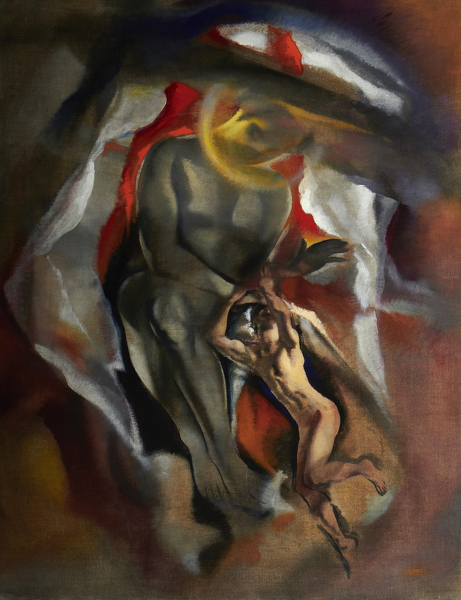
My Pain Beneath Your Sheltering Hand, c.1928
Framed (ref: 10571)
Tempera on canvas
Tags: Charles Sims tempera allegory religion 1.Master Designs 1.PORTRAIT OF AN ARTIST Hidden Gems - Nudes

Tempera on canvas
Tags: Charles Sims tempera allegory religion 1.Master Designs 1.PORTRAIT OF AN ARTIST Hidden Gems - Nudes
Provenance: John Robert Esq., thence by descent; private collection
Literature: Llewellyn, Sacha, and Paul Liss. Portrait of an Artist. Liss Llewellyn, 2021, p.361.
Exhibited: Royal Academy, Commemorative Exhibition of Works by late Members. Winter Exhibition, 52nd year, 7 January 1933 to 11 March 1933. no. 461; Walker Art Gallery, Liverpool.
This painting belongs to a small series of works that Charles Sims called his ‘Spiritual Ideas’. Tragically, the artist took his own life just weeks after completing them, and having submitted six for inclusion at the Royal Academy Summer Exhibition of 1928.
Grouped together in Gallery XI, Timothy Wilcox writes that ‘the paintings were among the most advanced, stylistically, that the Royal Academy had ever seen.’ This was an opinion echoed by commentators of the time, with one reviewer stating that the paintings struck a deeper and a more intense note than anything else at the Academy’ (“Royal Academy”, The Times, 5 May 1928). The critic from the Western Mail called them the ‘sensation of the year’ (5th May, 1928), whilst another noted that ‘it was impossible at times to get near the pictures because of the crowds’ (Aberdeen Press and Journal, 5th May, 1928).
In a longer review for the Mail, Fred A. Farrell speaks of the ‘genius’, and ‘startling volte force’ of the series.
‘In life, Sims’ work was mainly on scholarly but orthodox lines. In his death he has left the world in his last pictures a problem which no one but himself can solve’. The Mail, 5th May 1928, p. 8
There was a widespread assumption at the time that Sims was suffering from some sort of mental illness when he painted these pictures, which was only reinforced by the fact of his suicide. His depression was too much of a taboo to be mentioned openly, and was addressed only by Frank Rutter, critic of The Sunday Times, who broached it on sympathetic terms: “to suggest that there are traces of mania in these last and most beautiful works from his brush betrays a lamentable lack of understanding.”